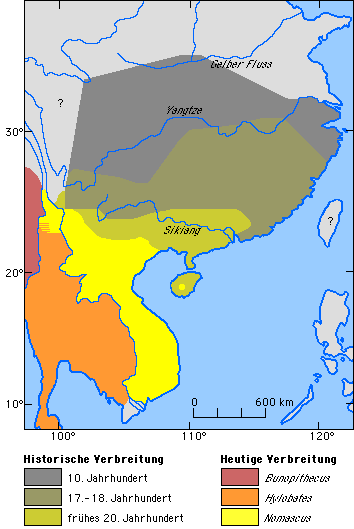Back to the Introduction index
![]() German version
German version
8. The Gibbons in China |
Back to the Introduction index
![]() German version
German version
8. The Gibbons in China |
Interactions between humans and gibbons have a long history in China, as reflected in the Chinese literature and art. Especially in early China, gibbons made the objects of many literary and artistic compositions.
The popularity of captive gibbons being kept as pets appears to go as far back as written history, although a proverb by the philosopher Huai-nan-tzû (died 122 B.C.) stated: "If you put a gibbon inside a cage, you might as well keep a pig. It is not because the gibbon is then not clever or swift anymore, but because he has no opportunity for displaying his abilities" (van Gulik, 1967, p. 40).
The traditional method to catch a live gibbon always consisted in looking for a female carrying an infant, then killing the mother with an arrow or a poisoned dart from a blow-pipe and taking the infant still clinging to her when she has fallen dead onto the ground. Humans often became deeply attached to their pet gibbons. When a king of the Chou dynasty (i.e. Chuang-wang, 613-591 B.C.) had lost his gibbon, he had an entire forest laid waste in order to find him.
In ancient China, gibbons were often considered being a symbol of the world of the supernatural, mysterious and remote from man's daily life. According to Taoist beliefs harking back to about 150 B.C., the occult powers of gibbons included the ability to assume human shape and to prolong their life to several hundred years. Even in later dynasties, gibbons often served as examples for the ideal human existence and were represented in numerous paintings of varying naturalism (Figure 8.1).
|
|
|
Figure 8.1. Left: "Gibbon grasping spider", fan painting, 11 century, possibly by Yi Yuanji (Museum of the Imperial Palace, Beijing). Right: "Captive gibbon and fruits", early 17. century, Ming copy of a painting by Yi Yuanji (11. century) (Freer Gallery, Washington D.C.; from Lovell, 1981, p. 65).
It was, however, first and foremost the gibbon's call that impressed Chinese poets of succeeding centuries. The songs of gibbons (especially in the famous Yangtze gorges) were frequently mentioned in poems. The calls were usually associated with sadness and became a symbol of the melancholy of travelers far from home.
In the 4th century, the poet and musician Yüan Sung wrote (Van Gulik, 1967, p. 46):
Sad the calls of the gibbons at the three gorges of Pa-tung;
After three calls in the night, tears wet the [traveler's] dress.
The crown-prince of Liang, Hsiao T'ung (501-531 A.D.), wrote the following couplet (Van Gulik, 1967, p. 53):
Hearing the gibbons call, inch by inch my entrails are torn,
Listening to the cranes, pair by pair my tears flow down.
Knowledge on the provenance and date of poems and paintings makes it possible to reconstruct the earlier distribution of gibbons in China and to document what may be the largest collapse in the distribution area among any group of primates in historical times (Figure 8.2). The preserved written and painted historical documents show that in the 10th century, gibbons were distributed over large parts of China up to the Yellow River. The northern frontier of their range lay apparently around the 35th parallel of latitude (about the latitude of Kyoto in Japan), and their distribution area may have covered about three-fourths of China. After the 10th century, the distribution area of gibbons began to shrink in central China and then in most other parts of the country. The reduction of the distribution are may largely be due to hunting and habitat loss. Today, Chinese gibbons are confined to southern Yunnan province and - in a few individuals - to Hainan island.

Figure 8.2. Historical and present distribution of gibbons in China and adjacent regions (after Geissmann, 1995).
Historical Chinese literature and art documents also demonstrate that gibbons lived in regions where winters were severe, and many poets refer to gibbons seen in winter. Li Po (701-762 A.D.) wrote the following brief poem on gibbons in southern Anhui province (Van Gulik, 1967, p. 61):
The splendor of the mountains shivers under the accumulated snow,
Like shadows the gibbons are hanging from the cold branches.
In contrast to gibbons living today, whose distribution is confined to tropical, subtropical and a few mountain forests, these extinct Chinese gibbons inhabited much cooler climate zones. We don't know what kind of gibbons these were, and their extinction leaves many open questions: How did they live in deciduate forests, how could they survive winter, what did they eat, what was their social structure? These questions may never be answered.